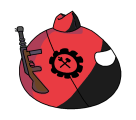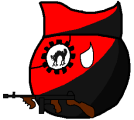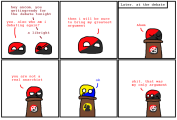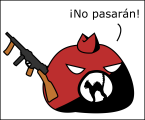Anarcho-Syndicalism (AnSynd) is an Anarchist, Economically Left and Culturally Varied (but usually ![]() progressive) ideology. AnSynd believes that an anarchist society should be based around decentralized worker-controlled associations under the name of "syndicates" (which is the French word for "trade union", although syndicates in this context are more sophisticated than mere trade unions). And more specifically, the achievement of anarchism by union lead strikes and direct action. Anarcho-Syndicalism has been widely accepted in anarchist circles (with
progressive) ideology. AnSynd believes that an anarchist society should be based around decentralized worker-controlled associations under the name of "syndicates" (which is the French word for "trade union", although syndicates in this context are more sophisticated than mere trade unions). And more specifically, the achievement of anarchism by union lead strikes and direct action. Anarcho-Syndicalism has been widely accepted in anarchist circles (with ![]() one notable exception). He inspired everybody's favorite crusty old white man socialist, (out of the approximate 67.54 billion of them), Noam Chomsky. AnSynd is also very fond of wildcat strikes.
one notable exception). He inspired everybody's favorite crusty old white man socialist, (out of the approximate 67.54 billion of them), Noam Chomsky. AnSynd is also very fond of wildcat strikes.
History
Anarcho-Syndicalism is an ideology which came out of the workers movements of the early 20th Century. It came to prominence primarily in the Catalonia region of Spain under the CNT (Confederación Nacional del Trabajo, National Confederation of Labor in English) in 1910. Starting with only 27,000 members it quickly swelled to 700,000 members by 1917. Though it saw success in other countries as well with the founding of international syndicalist organizations occurring in the same decade. Such as the IWA (International Workers Association) in Germany and the IWW (Industrial Workers of the World) in the United States.
The CNT-FAI and the Spanish Civil War
While all organizations would organize strikes, unions, and other pro-worker and pro-socialist events, the CNT would be the only one of these organizations to put the ideology into practice. In 1936, after an attempted coup by Francisco Franco, the CNT-FAI (The two organizations had merged by this point) would be one of the many organizations to resist the coup. The resistance held for long enough to transform the incident into a Civil War. The civil war would be divided into two primary sides with several factions in each. The Nationalists versus the Republicans. The Syndicalists belonged to the Republican side, a primarily leftist force which allied itself to the previous democratic government. (History video on factions in the Republican side) The CNT-FAI would seize the means of production within the Catalonian region within the first few months of the conflict. Dramatically altering the daily lives of the Catalonians by removing traditional hierarchies as George Orwell notes in "Homage to Catalonia."
The CNT-FAI took over the various factories, farms, dockyards, and other facilities within Catalonia and put them under the control of local unions. Improving the wages and working conditions of the masses. This combined with the civil war lead to the revolutionary wave across Catalonia.
The work the CNT-FAI did allowed for the quick arming of their militia units. These units were distinct from the traditional army structure as there was no enforceable hierarchy among the troops. The men could refuse orders if they all agreed their superior wasn't making a good call, as well they didn't have to address their superiors formally. The impact of this structure on their effectiveness as a military force is debated. What is undebatable is that they were able to form these militias quickly which lead to early gains in the war. Including the territory of Aragon which they formed into it's own autonomous government rather than control directly themselves.
Creating the Regional Defense Council of Aragon with the newly taken territory. Though tensions between the two quickly broke out as their visions conflicted. Attempts to suppress the Argon government were made in the CNT council, which only further hurt the relations between the two. This would only be the start of the CNT-FAI's troubles with other factions in the civil war.
The Popular Front faction known as the UGT (Unión General de Trabajadores, General Worker's Union in English), began to make moves to end the control of other factions on the Republican side. Being backed by the Soviet Union, they were the strongest faction. The first group they made moves against was the Trotskyists within the POUM (Partido Obrero de Unificación Marxista, The Worker's Party for Marxist Unification in English) killing and arresting top members, before moving on to arresting regular members as well. A similar fate would befall the CNT-FAI who were already losing influence in Catalonia to the Popular Front. The city of Barcelona was no longer worker controlled due to the lowered influence of the CNT-FAI. They had many issues due to the Popular Front's harassment of their government, until finally the Popular Front made moves to arrest and kill the CNT-FAI leaders. From there the CNT-FAI would exist as a shell of itself until the end of the War on April 1st 1939.
The CNT-FAI still exists today, albeit with far less influence than it once had. It came back after Franco died and Spain returned to a democracy. It mostly organizes union work and lower level leftist activities in modern Spain.
Personality
Unlike his brother ![]() AnCom who acts like a stereotypical rebellious teen, AnSynd is a dark and brooding character that likes to play Kaiserreich. His personality can be described as a caricature of a film-noir gangster. His aesthetics and personality are based on the 1920s. His native language is European Spanish. He hates being mistaken for his brother.
AnCom who acts like a stereotypical rebellious teen, AnSynd is a dark and brooding character that likes to play Kaiserreich. His personality can be described as a caricature of a film-noir gangster. His aesthetics and personality are based on the 1920s. His native language is European Spanish. He hates being mistaken for his brother.
Variants
 Cocoon Communism
Cocoon Communism
Cocoon Communism basically says anarcho-communism for internal policy, so society would structure itself that way. It is more focused internally and the CNT-FAI is debatably an example of this.
How to Draw
Symbols
Different syndicalist symbols can be used to represent AnSynd.
- A
 crossed torch and hammer is used to represent Syndicalists in the fictional universe of Kaiserreich. While this symbol is easily recognizable online, it was not used in real life.
crossed torch and hammer is used to represent Syndicalists in the fictional universe of Kaiserreich. While this symbol is easily recognizable online, it was not used in real life. - A three-pointed red star was used by Republican factions in the Spanish Civil War.
- A black cat emblem is used by the IWW, a modern-day syndicalist organization.
- An emblem with Hercules was used by the CNT in the Spanish Civil War.
Drawing
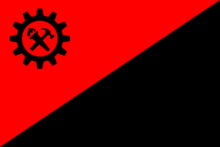
- Draw
 Anarcho-Communism.
Anarcho-Communism. - Replace the left eye with a Gear-shaped eye-patch.
- In the eye-patch draw one of the aforementioned syndicalist symbols.
Props
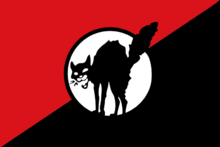
Anarcho-Syndicalism may have a variety of props, mostly based on 1920s aesthetic:
- CNT-FAI hat from the Spanish Civil War.
- 1920s gangster fedora.
- 1920s-style Tommy Gun.
- Cigarette or cigar.
| Color Name | HEX | RGB | |
|---|---|---|---|
| Red | #FF0000 | 255, 0, 0 | |
| Black | #141414 | 20, 20, 20 | |
Relationships
Comrades
 Anarcho-Communism - After our fierce debate on how anarchist society should work we like to get together and enjoy our presence.
Anarcho-Communism - After our fierce debate on how anarchist society should work we like to get together and enjoy our presence. Mutualism - He's cool too.
Mutualism - He's cool too. Geosyndicalism - Fellow syndie and also has that cool lvt.
Geosyndicalism - Fellow syndie and also has that cool lvt. Green Syndicalism - We're both syndicalists and environmentalists! Based!
Green Syndicalism - We're both syndicalists and environmentalists! Based! Eco-Anarchism - Supports the environment? Anarchist? Anti-capitalist? What can I say? Based!
Eco-Anarchism - Supports the environment? Anarchist? Anti-capitalist? What can I say? Based! Independence Anarchism - Freedom for Catalonia!
Independence Anarchism - Freedom for Catalonia! Separatism - Glad to see you helped liberate Catalonia (although many of my supporters are iffy on the whole "nationalism" thing)
Separatism - Glad to see you helped liberate Catalonia (although many of my supporters are iffy on the whole "nationalism" thing) Libertarian Possibilism - Reformist friend.
Libertarian Possibilism - Reformist friend.
Frenemies
 National Syndicalism - Syndicalism is based, but why so nationalist and reactionary?
National Syndicalism - Syndicalism is based, but why so nationalist and reactionary? Probably the only fascist I won't kill. Trotskyism - We were brothers in the Civil War, but for some reason called me "Makhnovia".
Trotskyism - We were brothers in the Civil War, but for some reason called me "Makhnovia".  Anarcho-Communism tells me not to trust you.
Anarcho-Communism tells me not to trust you. Luxemburgism - I do like that you support workers councils, but seriously cool it with the statism and we can be better friends.
Luxemburgism - I do like that you support workers councils, but seriously cool it with the statism and we can be better friends. Post-Leftism - The hell is your problem man?
Post-Leftism - The hell is your problem man? Machajskism - What do you mean by "Noam Crigensky"? Is that supposed to be an insult?
Machajskism - What do you mean by "Noam Crigensky"? Is that supposed to be an insult? Vaushism - You claim you're me, but I'm not so sure... Especially since you support "deplatforming" and silencing opponents via "canceling" it makes me question your claimed libertarian leanings. Also over the years you've become less anarchist and more statist and reformist.
Vaushism - You claim you're me, but I'm not so sure... Especially since you support "deplatforming" and silencing opponents via "canceling" it makes me question your claimed libertarian leanings. Also over the years you've become less anarchist and more statist and reformist. Titoism - Co-ops are based, but cool it with the authoritarianism.
Titoism - Co-ops are based, but cool it with the authoritarianism. And stop being so hard on Milošević. He wasn't really that bad. Chomsky said so. Market Socialism - Less statist version of the above. Still a bit too moderate for my liking.
Market Socialism - Less statist version of the above. Still a bit too moderate for my liking. Hoppeanism - Ancap, but who likes me? Now I've seen everything...
Hoppeanism - Ancap, but who likes me? Now I've seen everything...
Enemies
 Sankarism
Sankarism  - THOUSANDS OF TEACHERS WERE KILLED FOR STRIKING IN BURKINA FASO BECAUSE OF YOU!
- THOUSANDS OF TEACHERS WERE KILLED FOR STRIKING IN BURKINA FASO BECAUSE OF YOU! Monarchism - Strange women lying in ponds distributing swords is no basis for a system of government.
Monarchism - Strange women lying in ponds distributing swords is no basis for a system of government. Ingsoc - Might as well be a Nazi.
Ingsoc - Might as well be a Nazi. Nazism - LITERALLY A NAZI!
Nazism - LITERALLY A NAZI! Marxism–Leninism - Backstabbed me when the Republicans needed unity the most. We lost the war quicker thanks to you! And stop confusing me for
Marxism–Leninism - Backstabbed me when the Republicans needed unity the most. We lost the war quicker thanks to you! And stop confusing me for  AnCom! We are NOT the same!
AnCom! We are NOT the same! Capitalism - GIVE ME A RAISE GODDAMNIT.
Capitalism - GIVE ME A RAISE GODDAMNIT. Longism - You represent everything I hate about nationalists using left wing economics to suppress worker control of the means of production. Also, do you keep having dreams about fighting in a second American Civil War in some alternate world?
Longism - You represent everything I hate about nationalists using left wing economics to suppress worker control of the means of production. Also, do you keep having dreams about fighting in a second American Civil War in some alternate world? Anarcho-Capitalism - More like Neo-Feudalism.
Anarcho-Capitalism - More like Neo-Feudalism. Reactionary Socialism - You represent everything socialism is NOT supposed to be!
Reactionary Socialism - You represent everything socialism is NOT supposed to be! National Capitalism - The State, Racism, Fascism, Capitalism. It's everything that's wrong with humanity.
National Capitalism - The State, Racism, Fascism, Capitalism. It's everything that's wrong with humanity. Falangism - Stop gloating about "winning the war"!
Falangism - Stop gloating about "winning the war"!  Franco backstabbed you, you idiot!
Franco backstabbed you, you idiot! Francoism - FUCK YOU FOR BEATING ME IN THE WAR! REEEEEEEEEEEEE!
Francoism - FUCK YOU FOR BEATING ME IN THE WAR! REEEEEEEEEEEEE! Mediacracy - STOP MANUFACTURING CONSENT YOU SICK FUCK!
Mediacracy - STOP MANUFACTURING CONSENT YOU SICK FUCK! Catholic Theocracy - Lmao get purged
Catholic Theocracy - Lmao get purged Neocameralism - How is making the state corporate and having reactionary values gonna fix the issues of our world?
Neocameralism - How is making the state corporate and having reactionary values gonna fix the issues of our world? Anarcho-Nihilism - What did you mean when you said that you aren't just worker?
Anarcho-Nihilism - What did you mean when you said that you aren't just worker? Illegalism - You are harmful for workers!
Illegalism - You are harmful for workers! Insurrectionary Anarchism - Workers can use some violence towards oppressive bosses, but you want to destroy our unions, federations and councils also.
Insurrectionary Anarchism - Workers can use some violence towards oppressive bosses, but you want to destroy our unions, federations and councils also.
Further Information
Literature
- Anarcho-Syndicalism: Theory and Practice by Rudolf Rocker
- Homage to Catalonia (audio book version) by
 George Orwell
George Orwell 
- On Anarchism by Noam Chomsky
- The Anarchist Collectives by Sam Dolgoff
- Collectives in the Spanish Revolution by Gaston Leval
Wikipedia
- Anarcho-syndicalism
- Workers' self-management
- Mutual aid
- General strike
- Direct democracy
- Noam Chomsky
- Confederación Nacional del Trabajo
- LaborNet
Videos
- Anarchism, Explained (Taylor Avella)
- Fury Over Spain (1937 American Documentary about the Anarchists in the Spanish Civil War)
- Noam Chomsky on Anarcho-syndicalism (Chomsky's Philosophy)
- The Black Bloc: Inside America’s Hard Left (VICE)
- The Anarchists of the Spanish Civil War (Step Back History)
- Monty Python "Anarcho-Syndicalist Commune" (Monty Python & The Holy Grail)
Online Communities
Gallery
-
-
Alt design
-
-
-
| | |
| | |
Notes
- ↑ As he has said in his work "on anarchism" "Let me just say that I don’t really regard myself as an anarchist thinker" and anarchist
 Bob Black has also criticized Chomsky for being a statist.
Bob Black has also criticized Chomsky for being a statist.
